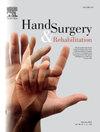Surface replacing proximal interphalangeal joint arthroplasty in patients with post-traumatic versus primary osteoarthritis
IF 1
4区 医学
Q4 ORTHOPEDICS
引用次数: 0
Abstract
Objective
The study compared clinical and patient-reported outcomes after proximal interphalangeal (PIP) joint surface replacement in patients with post-traumatic osteoarthritis (OA) and primary OA.
Methods
Data from a prospective registry of patients who underwent surface replacing PIP joint arthroplasty (CapFlex-PIP, KLS Martin, Germany) were analysed. The primary outcome was active range of motion (ROM) measured before surgery and at several times up to five years after surgery. Grip strength, the brief Michigan Hand Outcomes Questionnaire (MHQ) and pain during daily activities were also assessed. Using propensity score matching, 22 patients with post-traumatic OA were matched to 110 patients with primary OA based on their preoperative (baseline) ROM. Between-group differences were analysed using the Mann-Whitney U test or Fisher’s exact test.
Results
After matching, the mean baseline ROM of 34° (95% confidence interval [CI]: 22 to 46) for post-traumatic OA patients and 38° (CI: 34 to 42) for primary OA patients were comparable. By one year, ROM improved significantly after PIP arthroplasty to 53° (CI: 45 to 61) and 59° (CI: 55 to 63) for post-traumatic and primary OA patients respectively, and there was no significant difference between groups (p = 0.103). Thereafter, ROM declined in a similar manner for both groups over the 5-year follow-up period. The brief MHQ score and grip strength at baseline and the 1-year follow-up were significantly higher in the post-traumatic OA group. Complications occurred in five post-traumatic OA patients (23%) and in 15 patients (14%) with primary OA (p = 0.327).
Conclusion
Proximal interphalangeal joint surface replacement arthroplasty for post-traumatic osteoarthritis significantly improved range of motion, and this trend was similar to that achieved for patients with primary osteoarthritis. As clinical and patient-reported outcomes also improved, we recommend this procedure for patients with post-traumatic osteoarthritis, but the potentially higher risk of complications and reoperations for post-traumatic osteoarthritis patients should be considered.
表面置换近端指间关节置换术在创伤后与原发性骨关节炎患者中的应用。
目的:比较创伤后骨关节炎(OA)和原发性OA患者近端指间关节面置换术的临床和患者报告的结果。方法:对接受表面置换PIP关节置换术(CapFlex-PIP, KLS Martin,德国)患者的前瞻性登记数据进行分析。主要结果是术前和术后5年内多次测量的活动范围(ROM)。握力、简短的密歇根手部问卷(MHQ)和日常活动中的疼痛也进行了评估。使用倾向评分匹配,根据术前(基线)ROM将22例创伤后OA患者与110例原发性OA患者进行匹配。使用Mann-Whitney U检验分析组间差异。结果:匹配后,创伤后OA患者的平均基线ROM为34°(95%可信区间[CI]: 22至46),原发性OA患者的平均基线ROM为38°(CI: 34至42),两者具有可比性。一年后,PIP关节置换术后,创伤后和原发性OA患者的ROM分别显著改善至53°(CI: 45 ~ 61)和59°(CI: 55 ~ 63),两组间无显著差异(p = 0.103)。此后,在5年的随访期间,两组的ROM以类似的方式下降。在基线和1年随访时,创伤后OA组的简短MHQ评分和握力明显更高。5例创伤后OA患者(23%)和15例原发性OA患者(14%)出现并发症(p = 0.327)。结论:创伤后骨关节炎患者近端指间关节面置换术可显著改善关节活动度,这一趋势与原发性骨关节炎患者相似。由于临床和患者报告的预后也有所改善,我们建议创伤后骨关节炎患者采用这种手术,但创伤后骨关节炎患者的并发症和再手术的潜在风险较高,应予以考虑。
本文章由计算机程序翻译,如有差异,请以英文原文为准。
求助全文
约1分钟内获得全文
求助全文
来源期刊

Hand Surgery & Rehabilitation
Medicine-Surgery
CiteScore
1.70
自引率
27.30%
发文量
0
审稿时长
49 days
期刊介绍:
As the official publication of the French, Belgian and Swiss Societies for Surgery of the Hand, as well as of the French Society of Rehabilitation of the Hand & Upper Limb, ''Hand Surgery and Rehabilitation'' - formerly named "Chirurgie de la Main" - publishes original articles, literature reviews, technical notes, and clinical cases. It is indexed in the main international databases (including Medline). Initially a platform for French-speaking hand surgeons, the journal will now publish its articles in English to disseminate its author''s scientific findings more widely. The journal also includes a biannual supplement in French, the monograph of the French Society for Surgery of the Hand, where comprehensive reviews in the fields of hand, peripheral nerve and upper limb surgery are presented.
Organe officiel de la Société française de chirurgie de la main, de la Société française de Rééducation de la main (SFRM-GEMMSOR), de la Société suisse de chirurgie de la main et du Belgian Hand Group, indexée dans les grandes bases de données internationales (Medline, Embase, Pascal, Scopus), Hand Surgery and Rehabilitation - anciennement titrée Chirurgie de la main - publie des articles originaux, des revues de la littérature, des notes techniques, des cas clinique. Initialement plateforme d''expression francophone de la spécialité, la revue s''oriente désormais vers l''anglais pour devenir une référence scientifique et de formation de la spécialité en France et en Europe. Avec 6 publications en anglais par an, la revue comprend également un supplément biannuel, la monographie du GEM, où sont présentées en français, des mises au point complètes dans les domaines de la chirurgie de la main, des nerfs périphériques et du membre supérieur.
 求助内容:
求助内容: 应助结果提醒方式:
应助结果提醒方式:


